酶学性质研究
- 格式:pdf
- 大小:124.31 KB
- 文档页数:8
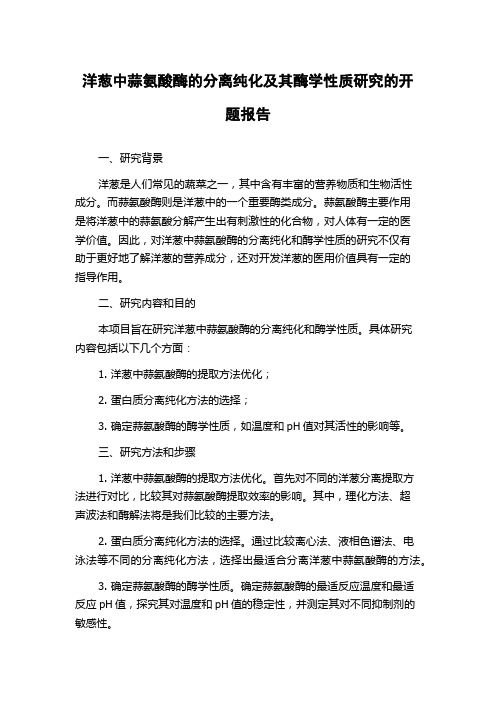
洋葱中蒜氨酸酶的分离纯化及其酶学性质研究的开题报告一、研究背景洋葱是人们常见的蔬菜之一,其中含有丰富的营养物质和生物活性成分。
而蒜氨酸酶则是洋葱中的一个重要酶类成分。
蒜氨酸酶主要作用是将洋葱中的蒜氨酸分解产生出有刺激性的化合物,对人体有一定的医学价值。
因此,对洋葱中蒜氨酸酶的分离纯化和酶学性质的研究不仅有助于更好地了解洋葱的营养成分,还对开发洋葱的医用价值具有一定的指导作用。
二、研究内容和目的本项目旨在研究洋葱中蒜氨酸酶的分离纯化和酶学性质。
具体研究内容包括以下几个方面:1. 洋葱中蒜氨酸酶的提取方法优化;2. 蛋白质分离纯化方法的选择;3. 确定蒜氨酸酶的酶学性质,如温度和pH值对其活性的影响等。
三、研究方法和步骤1. 洋葱中蒜氨酸酶的提取方法优化。
首先对不同的洋葱分离提取方法进行对比,比较其对蒜氨酸酶提取效率的影响。
其中,理化方法、超声波法和酶解法将是我们比较的主要方法。
2. 蛋白质分离纯化方法的选择。
通过比较离心法、液相色谱法、电泳法等不同的分离纯化方法,选择出最适合分离洋葱中蒜氨酸酶的方法。
3. 确定蒜氨酸酶的酶学性质。
确定蒜氨酸酶的最适反应温度和最适反应pH值,探究其对温度和pH值的稳定性,并测定其对不同抑制剂的敏感性。
四、预期结果和意义通过对洋葱中蒜氨酸酶的分离纯化和酶学性质的研究,我们期望得到以下预期结果:1. 确定出一种有效的洋葱蒜氨酸酶提取方法;2. 选择出一种最适合分离纯化洋葱中蒜氨酸酶的蛋白质分离方法;3. 确立蒜氨酸酶的酶学性质,为未来开发洋葱的医用价值提供科学依据。
五、研究进度和计划目前,我们已完成洋葱的采集和初步试验。
接下来,我们将对不同的提取方法进行对比实验,选择出最佳的提取方法,并开始对提取得到的蛋白质进行分离纯化。
在得到纯化的蒜氨酸酶后,我们将结合不同的试验条件,确定蒜氨酸酶的酶学性质。
我们预计整个研究项目将在6个月内完成。
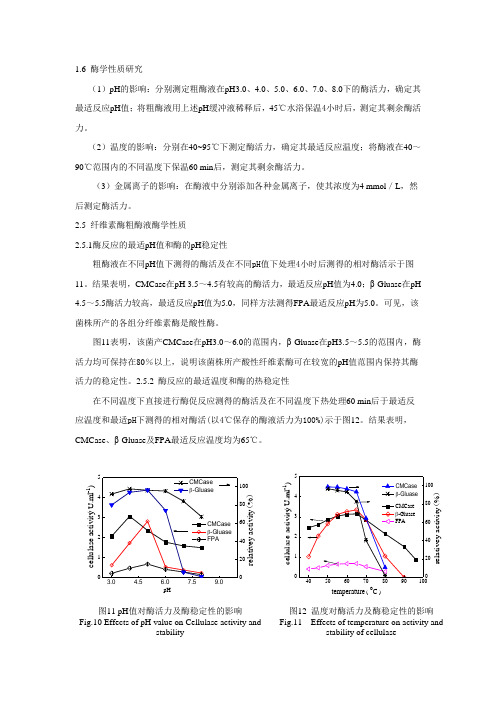
1.6 酶学性质研究(1)pH 的影响:分别测定粗酶液在pH3.0、4.0、5.0、6.0、7.0、8.0下的酶活力,确定其最适反应pH 值;将粗酶液用上述pH 缓冲液稀释后,45℃水浴保温4小时后,测定其剩余酶活力。
(2)温度的影响:分别在40~95℃下测定酶活力,确定其最适反应温度;将酶液在40~90℃范围内的不同温度下保温60 min 后,测定其剩余酶活力。
(3)金属离子的影响:在酶液中分别添加各种金属离子,使其浓度为4 mmol /L ,然后测定酶活力。
2.5 纤维素酶粗酶液酶学性质2.5.1酶反应的最适pH 值和酶的pH 稳定性粗酶液在不同pH 值下测得的酶活及在不同pH 值下处理4小时后测得的相对酶活示于图11。
结果表明,CMCase 在pH 3.5~4.5有较高的酶活力,最适反应pH 值为4.0;β-Gluase 在pH 4.5~5.5酶活力较高,最适反应pH 值为5.0,同样方法测得FPA 最适反应pH 为5.0。
可见,该菌株所产的各组分纤维素酶是酸性酶。
图11表明,该菌产CMCase 在pH3.0~6.0的范围内,β-Gluase 在pH3.5~5.5的范围内,酶活力均可保持在80%以上,说明该菌株所产酸性纤维素酶可在较宽的pH 值范围内保持其酶活力的稳定性。
2.5.2 酶反应的最适温度和酶的热稳定性在不同温度下直接进行酶促反应测得的酶活及在不同温度下热处理60 min 后于最适反应温度和最适pH 下测得的相对酶活(以4℃保存的酶液活力为100%)示于图12。
结果表明,CMCase 、β-Gluase 及FPA 最适反应温度均为65℃。
c e l l u l a s e a c t i v i t y ( U .m l -1)pHr e l a t i v e y a c t i v i t y (%)c e l l u l a s e a c t i v i t y ( U .m l -1)temperature ( o C )r e l a t i v e y a c t i v i t y (%)图11 pH 值对酶活力及酶稳定性的影响Fig.10 Effects of pH value on Cellulase activity andstability 图12 温度对酶活力及酶稳定性的影响 Fig.11 Effects of temperature on activity andstability of cellulase图12表明,温度低于60℃时,CMCase和β-Gluase能保持90%以上的酶活性,酶液在80℃下保温1小时,CMCase仍保持10%的活性,70℃热处理1小时,β-Gluase活性仅损失60%。

酶学的研究及应用酶学是生物学的一个分支,主要研究酶的特性、机制、结构和功能,以及其在生命活动中的作用和应用。
酶作为生物催化剂,能够加速和调控生物体内化学反应的进行,使得生命体系能够保持稳定和良好运转。
酶学的研究对于理解生命活动的机制和探索新药物、新材料等具有重要的意义。
酶特性的研究是酶学的基础。
酶的特性包括相对分子质量、等电点、结构、催化机理等。
通过对这些特性的研究,可以深入了解酶分子的结构和功能。
例如,对于酶的催化机理的研究能够揭示酶催化反应的关键步骤和反应机制。
这些方面的研究对于深入理解生命活动的本质具有重要的意义。
另外,酶学还研究酶的工业应用。
酶作为一种高效、特异性的催化剂,被广泛应用于工业生产过程中。
例如,在纺织、食品、制药等行业中,酶被用作清洁剂、食品添加剂、药物生产等。
还有一些新的应用领域,如酶用于制备生物燃料、生物降解、废水处理等。
酶学的应用不仅能够提高生产效率,降低生产成本,还能够保护环境和食品安全。
近年来,酶学研究在生物医学领域得到了广泛应用。
酶与生物体内各种代谢过程密切相关,许多疾病的发生与酶活性的变化有关。
例如,糖尿病、心血管疾病等都与酶活性的变化有关。
因此,通过对酶活性和酶特性的研究,可以为疾病的诊断和治疗提供重要的依据。
近年来,酶学研究在精准医学和个性化治疗领域得到了越来越广泛的应用。
通过对酶的分子结构、催化机制、调控和修饰等方面的深入研究,人们可以揭示酶与疾病之间的关系,从而开发出更加精准和有效的药物。
总之,酶学研究是生物学和医学研究中不可或缺的一部分。
通过对酶的特性和应用的研究,我们可以更好地理解生命活动本质和探索新的治疗方法。
在未来的研究中,酶学将继续发挥着重要的作用,并为人类健康和生产生活带来更多的贡献。

甘露聚糖酶的酶学性质研究甘露聚糖酶是一种半纤维素水解酶,以内切方式降解β-1,4糖苷键,降解产物的非还原末端为甘露糖,其作用底物包括葡萄甘露聚糖、半乳甘露聚糖及β-甘露聚糖等。
它不仅能够降解肠道粘度,促进营养物质的消化和吸收,而且还可消除豆类中富含的β-甘露聚糖对葡萄糖吸收的干扰,极大提高饼粕尤其是豆粕的能量消化率;同时,添加了甘露聚糖酶后动物的抵抗力及整齐度都有提高。
甘露聚糖类物质作为半纤维素的第二大组分,广泛分布于自然界中。
它是所有豆科植物细胞壁的主要组成成分,在其他植物性饲料原料中含量也很高,如豆粕、小麦、菜籽粕、麸皮中半乳甘露聚糖占非淀粉多糖的含量分别为22.7%,11.9%,19.6%和33.7%。
我国猪、鸡的主要日粮是玉米/豆粕型日粮,尽管猪、鸡等单胃动物对玉米的消化率较高,但对豆粕的能量利用率仅为50%~60%。
单胃动物对豆粕能量的利用率如此低的原因可能是豆粕中含有22.7%左右的半纤维素是不能被单胃动物消化的非淀粉多糖。
饲料中添加甘露聚糖酶可以降解甘露聚糖、降低消化道内容物黏度,破坏植物性饲料细胞壁结构,使营养物质能与消化酶充分接触,提高内源酶的活性,改善肠道微生物菌群和提高肠粘膜的完整性等功能。
本文旨在通过对康地恩甘露聚糖酶的酶学性质研究,掌握有关数据,为实际应用提供理论依据和指导。
1材料与方法1.1 材料与试剂康地恩甘露聚糖酶;甘露聚糖(Sigma公司);3,5—二硝基水杨酸(DNS);甘露糖(Sigma公司)。
1.2 主要实验仪器 722型分光光度计;电子分析天平;可调恒温水浴锅;精密pH计等。
1.3 酶活力测定1.3.1酶活测定方法。
采用还原糖法(DNS)测定。
1.3.2 酶活力单位定义。
在40℃、pH4.5的条件下,每分钟从甘露聚糖(Sigma G0753)溶液中降解释放1 μg还原糖所需要的酶量为一个酶活力单位U。
1.3.3甘露糖标准曲线的绘制。
配制10mg/mL的甘露糖溶液100mL,吸取上述溶液分别配制成浓度为0.10~0.70 mg/mL的甘露糖标准溶液。

实验一酶的性质研究酶是生物体内具有催化功能的蛋白质,因此也叫生物催化剂。
生物体内存在多种多样的酶,从而使生物体在温和的条件下能够迅速完成复杂的生物化学反应。
酶有的是单纯蛋白质,有的是结合蛋白质。
因此,凡是能够引起蛋白质变性的因素,都可以使酶丧失活性,结合蛋白质的非蛋白部分叫做辅酶或辅基。
习惯上,将与蛋白质结合的紧而不易分离的非蛋白部分称为辅基,辅基不能通过透析的方法从酶分子中除去;而将与蛋白质结合的不紧而易分离的非蛋白质部分称为辅酶,辅酶可以通过透析的方法从酶分子中除去。
目前许多酶已经能够制成结晶。
酶具有高度的专一性(特异性)。
温度和pH对酶的活性有显著的影响。
能使酶的活性增加的作用称为酶的激活作用,使酶的活性增加的一些物质称为酶激活剂;能使酶的活性减弱的作用称为酶的抑制作用,使酶的活性减弱的一些物质称为酶的抑制剂。
激活剂与抑制剂常表现某种程度的特异性。
,物质代谢是生命现象的基本特征。
在机体中了解温度对没活性的影不断进行着的同化作用和异化作用,绝大多数都是在酶的影响下进行的。
所以,生活机能在某种程度内可以说是由机体内酶类的含量及活性决定的。
食品、发酵、制药、制革、造纸、纺织等工业部门以及临床检验等都和酶有密切关系。
因此,酶的研究在生物化学理论上及生产实践上都占有极其重要的位置。
温度对酶活性的影响一目的和要求通过检验不同温度下唾液淀粉酶的活性,了解温度对酶活性的影响。
进一步明确最适温度的概念。
二原理酶的催化作用受温度的影响很大,一方面与一般化学反应一样,提高温度可以增加酶促反应的速度。
通常温度每升高10℃,反应速度就加快一倍左右,通常用温度系数表示,一般情况下的温度系数约等于2,最后反应速度达到最大值。
另一方面,酶是一种蛋白质,温度过高可引起蛋白质变性,导致酶的失活。
因此,反应速度达到最大值以后,随着温度的升高,反应速度反而逐渐下降,以至完全停止反应。
反应速度达到最大值时的温度称为某种酶的最适温度。

淀粉酶酶学性质的研究摘要淀粉酶可将淀粉水解为麦芽糖和少量葡萄糖,它们遇碘呈现不同的颜色,根据这个性质对淀粉酶进行不同条件下的研究。
通过在不同条件下对酶的性质进行研究发现萌发小麦种子中淀粉酶的最适温度在40℃,随着温度的升高或降低都会对酶活性产生影响;萌发的小麦种子的淀粉酶最适pH在5.6左右,低于或高于最适pH酶的活性逐渐降低;研究还发现Cl¯是淀粉酶的激活剂而Cu²+则对淀粉酶有抑制作用。
关键词:淀粉酶 .不同条件性质淀粉是植物最主要的储藏多糖,也是人和动物的重要食物和发酵工业的基本原料。
淀粉经淀粉酶水解后生成葡萄糖和麦芽糖等小分子物质而被机体利用。
通过对小麦种子中淀粉酶酶学性质的研究可以用于农业研究用于食品¸工业原料等,还可以提高小麦的应用范围和利用率。
⒈材料与方法⒈⒈实验材料萌发的小麦种子⒈⒉实验设计称取2g萌发3天的小麦种子,置于研钵中,加入少量2ml蒸馏水,研磨匀浆。
将匀浆倒入刻度试管中,定容至25ml。
提取液在室温下放置提取15-20min,每隔数分钟搅动一次,使其充分提取。
然后在4000r/min转速下离心10min,将上清液倒入一个干净的试管中,即为淀粉酶粗酶液。
⒈⒊实验方法与结果⒈⒊⒈温度对淀粉酶活性的影响取8支试管,编号,按下表操作,并记录观察到的颜色。
管号 A a B b C c D d缓冲液(pH5.6)/ml 1.0 — 1.0 — 1.0 — 1.0 —淀粉溶液/ml 2.5 — 2.5 — 2.5 — 2.5 —淀粉酶提取液/ml — 1.0 — 1.0 — 1.0 — 1.0预保温/10min 4℃室温40℃沸水浴混合A→a B→b C→c D→d酶促反应(10min)4℃室温40℃沸水浴碘液各加3滴(滴管应先冷却至室温)显色浅蓝色无色无色蓝色低温时酶的活性低,但没有失活,随着温度升高,酶的活性越来越高,后来又降低当温度到达很高时酶失活。
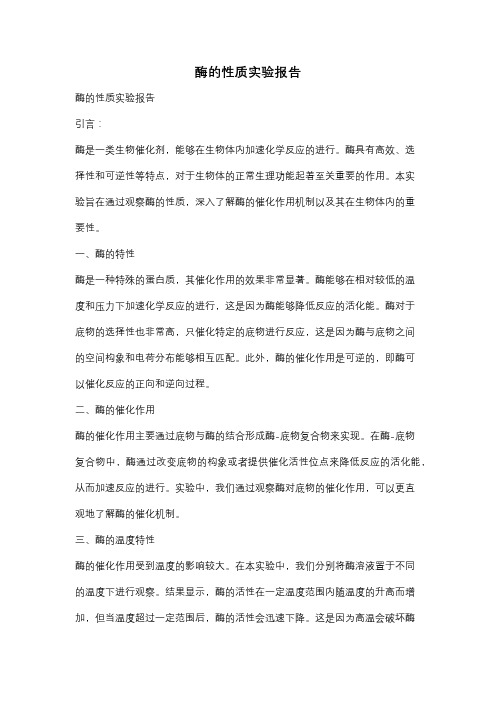
酶的性质实验报告酶的性质实验报告引言:酶是一类生物催化剂,能够在生物体内加速化学反应的进行。
酶具有高效、选择性和可逆性等特点,对于生物体的正常生理功能起着至关重要的作用。
本实验旨在通过观察酶的性质,深入了解酶的催化作用机制以及其在生物体内的重要性。
一、酶的特性酶是一种特殊的蛋白质,其催化作用的效果非常显著。
酶能够在相对较低的温度和压力下加速化学反应的进行,这是因为酶能够降低反应的活化能。
酶对于底物的选择性也非常高,只催化特定的底物进行反应,这是因为酶与底物之间的空间构象和电荷分布能够相互匹配。
此外,酶的催化作用是可逆的,即酶可以催化反应的正向和逆向过程。
二、酶的催化作用酶的催化作用主要通过底物与酶的结合形成酶-底物复合物来实现。
在酶-底物复合物中,酶通过改变底物的构象或者提供催化活性位点来降低反应的活化能,从而加速反应的进行。
实验中,我们通过观察酶对底物的催化作用,可以更直观地了解酶的催化机制。
三、酶的温度特性酶的催化作用受到温度的影响较大。
在本实验中,我们分别将酶溶液置于不同的温度下进行观察。
结果显示,酶的活性在一定温度范围内随温度的升高而增加,但当温度超过一定范围后,酶的活性会迅速下降。
这是因为高温会破坏酶的三维结构,使酶失去催化活性。
因此,在实际应用中,我们需要根据酶的特性来选择合适的温度条件。
四、酶的pH特性酶的催化作用还受到pH值的影响。
不同的酶对于酸碱度的适应范围不同,这与酶的结构和功能密切相关。
在实验中,我们调整了不同pH值的缓冲液,并将酶溶液加入其中进行反应。
结果显示,酶的活性在特定的pH值范围内最高,而在酸性或碱性条件下,酶的活性会显著下降。
这是因为酶的活性位点对于氢离子浓度非常敏感,酸碱度的改变会影响酶的结构和功能。
五、酶的浓度特性酶的催化活性还与酶的浓度密切相关。
在实验中,我们分别取不同浓度的酶溶液进行反应,并观察反应速率的变化。
结果显示,酶的活性随着酶浓度的增加而增加,但当酶浓度达到一定范围后,酶的活性不再增加。

木聚糖酶生产及酶学性质的研究一、本文概述木聚糖酶是一类能够水解木聚糖及其相关多糖的酶类,广泛存在于自然界中,尤其是在植物、微生物和动物体内。
由于其在生物质转化、食品加工、饲料工业以及医药等领域的重要应用价值,木聚糖酶的研究与生产日益受到关注。
本文旨在全面综述木聚糖酶的生产方法、纯化技术以及酶学性质的研究进展,以期为木聚糖酶的进一步研究和应用提供理论支持和实践指导。
本文将对木聚糖酶的生产方法进行详细阐述。
这包括从天然来源中提取木聚糖酶,以及通过微生物发酵、基因工程等生物技术手段生产木聚糖酶。
在此基础上,还将探讨不同生产方法的优缺点,以及影响木聚糖酶产量的关键因素。
本文将关注木聚糖酶的纯化技术。
纯化是获得高质量、高活性木聚糖酶的关键步骤,本文将介绍常见的纯化方法,如硫酸铵沉淀、离子交换层析、凝胶过滤层析等,并分析各方法的优缺点及适用范围。
本文将重点研究木聚糖酶的酶学性质。
这包括木聚糖酶的分子量、最适pH值、最适温度、动力学参数等基本性质,以及酶的稳定性、抑制剂和激活剂等影响因素。
通过对这些酶学性质的研究,可以更深入地了解木聚糖酶的作用机制和催化性能,为其在各个领域的应用提供理论依据。
本文旨在通过系统研究木聚糖酶的生产及酶学性质,为木聚糖酶的进一步研究和应用提供全面、深入的理论支持和实践指导。
二、木聚糖酶的生产方法木聚糖酶作为一种重要的工业酶,其生产方法主要包括微生物发酵法、化学合成法和基因工程法。
其中,微生物发酵法因其产量高、成本低、条件温和且易于工业化生产等优点,成为目前木聚糖酶生产的主要方法。
微生物发酵法生产木聚糖酶主要利用能够产生木聚糖酶的微生物,如真菌、细菌和放线菌等,通过优化培养基成分、发酵条件和菌种选育等手段,提高木聚糖酶的产量和活性。
目前,黑曲霉、米曲霉和里氏木霉等真菌是木聚糖酶的主要生产菌种。
在发酵过程中,碳源、氮源、无机盐和生长因子等营养成分对木聚糖酶的产量和活性具有重要影响。
常用的碳源包括木聚糖、葡萄糖、果糖等,氮源则包括蛋白胨、酵母粉、豆饼粉等。

实验四酶学性质研究一、实验目的1、了解pH、温度、金属离子对酶的活性的影响机理;2、掌握如何选择酶催化反应的最适pH、温度和获得最适pH条件的确定、以及Km常数的测定。
二、实验原理酶促反应速度受介质pH的影响,一种酶在几种pH介质中测其活力,可看到在某一pH时酶促效率最高,这个pH称为该酶的最适pH。
pH影响酶分子的活性部位的解离,另外,也影响底物的解离状态,从而影响酶活性中心的结合与底物或催化。
其次,有关基团解离状态的改变影响酶的空间构象,甚至会使酶变性。
酶的最适pH不是酶的特征性常数,如缓冲液的种类与浓度,底物浓度等均可改变酶作用的最适pH。
在一定温度范围内,酶促反应速率随温度的升高而加快;但当温度高到一定限度时,酶促反应速率不仅不再加快反而随着温度的升高而下降,最终,酶因高温变性失去活性,失去了催化能力。
在一定条件下,每一种酶在某一温度时活力最大,这个温度称为这种酶的最适温度在进行酶学研究时一般都要制作一条pH与酶活性的关系曲线,即保持其他条件恒定,在不同pH条件下测定酶促反应速度,以pH值为横坐标,反应速度为纵坐标作图。
由此曲线,不仅可以了解反应速度随pH值变化的情况,而且可以求得酶的最适pH。
最适温度的实验方法和pH类似。
酶促动力学研究酶促反应的速度及影响速度的各种因素,而米氏常数K m值等于酶促反应速度为最大速度一般时所对应的底物浓度,其值大小与酶的浓度无关,是酶促反应的特征常数。
不同酶的K m值不同,同一种酶与不同的底物反应时,其Km值也不同,Km值反映了酶和底物亲和力的强弱程度,Km值越大,表明酶和底物的亲和力越弱;Km值越小,表明酶与底物的亲和力越强。
酶的活力就是酶所催活的反应速度,通常用单位时间内底物的减少或产物的增加来表示。
酶反应过程中产物的生成和时间的关系可以用进程曲线来说明,曲线的斜率就是酶反应过程中的反应速度。
从进程曲线来看,在一定时间内反应速度维持恒定,但随着时间的延长,反应速度逐渐降低,这是由多种因素造成的。
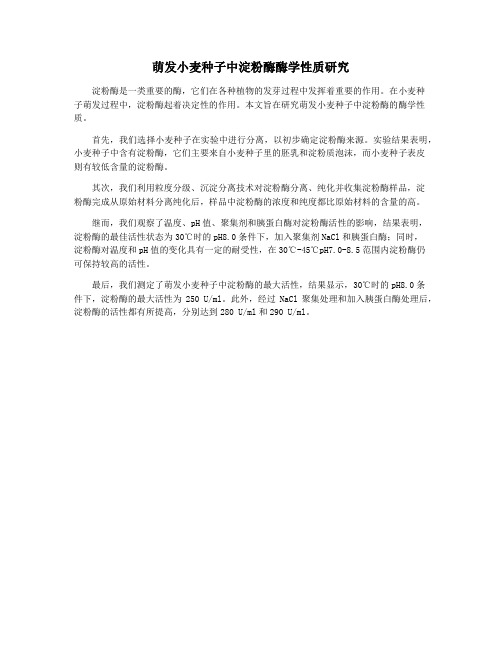
萌发小麦种子中淀粉酶酶学性质研究
淀粉酶是一类重要的酶,它们在各种植物的发芽过程中发挥着重要的作用。
在小麦种
子萌发过程中,淀粉酶起着决定性的作用。
本文旨在研究萌发小麦种子中淀粉酶的酶学性质。
首先,我们选择小麦种子在实验中进行分离,以初步确定淀粉酶来源。
实验结果表明,小麦种子中含有淀粉酶,它们主要来自小麦种子里的胚乳和淀粉质泡沫,而小麦种子表皮
则有较低含量的淀粉酶。
其次,我们利用粒度分级、沉淀分离技术对淀粉酶分离、纯化并收集淀粉酶样品,淀
粉酶完成从原始材料分离纯化后,样品中淀粉酶的浓度和纯度都比原始材料的含量的高。
继而,我们观察了温度、pH值、聚集剂和胰蛋白酶对淀粉酶活性的影响,结果表明,淀粉酶的最佳活性状态为30℃时的pH8.0条件下,加入聚集剂NaCl和胰蛋白酶;同时,
淀粉酶对温度和pH值的变化具有一定的耐受性,在30℃-45℃pH7.0-8.5范围内淀粉酶仍
可保持较高的活性。
最后,我们测定了萌发小麦种子中淀粉酶的最大活性,结果显示,30℃时的pH8.0条
件下,淀粉酶的最大活性为250 U/ml。
此外,经过NaCl聚集处理和加入胰蛋白酶处理后,淀粉酶的活性都有所提高,分别达到280 U/ml和290 U/ml。

酶学研究的基本原理及其应用酶学是研究酶的性质、结构、活性和功能的学科。
酶作为一种生物催化剂,在生命体内起着至关重要的作用。
酶学的研究对于生物科学、医学以及农业等领域都具有重要的理论和实践意义。
一、基本原理1. 酶的定义和特点酶是一种生物催化剂,它可以在生理条件下催化体内或体外发生的化学反应,使其速率大大加速。
酶是一种蛋白质,具有高度的专一性和灵敏度。
2. 酶的催化机理酶催化过程中主要包括四个步骤:亲合作用、过渡态形成、产物释放和酶的再生。
其中,亲合作用是指酶与底物的结合反应,形成酶-底物复合物;过渡态形成是指酶-底物复合物通过转移和/或变形产生过渡态;产物释放是指酶催化产生的产物从酶-底物复合物中解离出来;再生是指酶从产物和底物中解离出来,回到初始状态,可以开始新的催化过程。
3. 酶的性质和结构酶的性质包括专一性、灵敏度、催化速率、酶动力学等。
酶的结构包括原核生物和真核生物两种类型,其中真核生物酶的结构更加复杂。
二、应用领域1. 化学工业酶可以用于生产化学原料、化学品和制药等领域。
例如,用于生产纤维素、纤维素酶等。
2. 食品工业酶可以在食品加工中发挥重要作用。
例如,用于生产面包、啤酒、乳制品、红葡萄酒、肉制品等。
3. 医学领域酶在医学领域中有广泛的应用。
例如,酶可以用于制造各种药物,如激素、抗生素、病毒和肿瘤的治疗剂等。
4. 环境工程酶可以分解有害化学物质,清除水体和土壤污染物。
例如,可用于分解环境中的有毒物质,如苯、酚、农药等。
总之,酶学是一个重要的生物学科,在众多领域都发挥着不可替代的作用。
科学家们也在不断深入研究酶学的基本原理,以期在更广泛的领域中实现更好的应用和发挥。


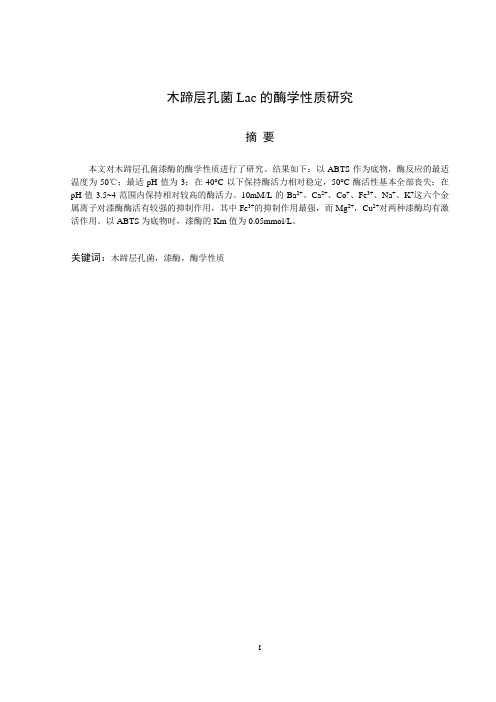
木蹄层孔菌Lac的酶学性质研究摘要本文对木蹄层孔菌漆酶的酶学性质进行了研究。
结果如下:以ABTS作为底物,酶反应的最适温度为50℃;最适pH值为3;在40°C以下保持酶活力相对稳定,50°C酶活性基本全部丧失;在pH值3.5~4范围内保持相对较高的酶活力。
10mM/L的Ba2+、Ca2+、Co+、Fe3+、Na+、K+这六个金属离子对漆酶酶活有较强的抑制作用,其中Fe3+的抑制作用最强,而Mg2+,Cu2+对两种漆酶均有激活作用。
以ABTS为底物时,漆酶的Km值为0.05mmol/L。
关键词:木蹄层孔菌,漆酶,酶学性质ENZYMATIC PROPERTIES STUDY OF TINDER FUNGUSLACCASEABSTRACTIn this paper, the tinder fungus enzymology properties of laccase were studied. Results are as follows: to ABTS as substrate, the enzyme reaction of the optimum temperature is 50 ℃; The optimal pH value is 3; Enzyme activity stabilization are under 40 °C, basic all lose enzyme activity under 50 °C; Within the scope of the pH value of 3.5 ~ 4 remained relatively high enzyme activity. 10 mm/L Co+, Ca2+, Ba2+, Fe3+, Na+, K+ the six metal ions on laccase enzyme activity had a stronger inhibitory effect, one of the strongest inhibitory effect of Fe3+, and Mg 2+, Cu2+ effect on two kinds of laccase are activated. ABTS as substrates, laccase Km value tendency for 0.05 L.Key words: tinder fungus,laccase,enzymatic properties目录第1章绪论 (1)1.1木蹄层孔菌国内外研究进展 (1)1.2漆酶国内外研究进展 (1)1.2.1漆酶理化性质 (2)1.2.2漆酶的应用 (3)第2 章材料和方法 (4)2.1实验材料与仪器 (4)2.1.1菌种 (4)2.1.2实验材料、试剂 (4)2.1.3实验仪器 (5)2.2实验方法 (5)2.2.1木蹄层孔菌的培养 (5)2.2.2粗酶液的制备 (5)2.2.3漆酶酶学性质 (6)2.2.5数据统计和分析 (7)第3章结果与分析 (8)3.1最适反应pH值及pH稳定性 (8)3.2最适温度及热稳定性 (9)3.3金属离子及抑制剂对漆酶活性的影响 (10)3.4Km (10)第4章讨论 (12)致谢 (13)参考文献 (14)第1章绪论1.1木蹄层孔菌国内外研究进展木蹄层孔菌(Fomes fomentarius(L.:Fr.)Kick.)是一种多孔菌科的高等药用真菌,是世界性分布的木腐性真菌[1]。

果胶酶高产菌株筛选发酵条件优化以及酶学性质的研究果胶酶是一种重要的工业酶,具有广泛的应用前景。
为了提高果胶酶的产量,本研究旨在筛选果胶酶高产菌株,并优化其发酵条件,同时对其酶学性质进行研究。
首先,我们从自然环境中采集了一系列样品,包括土壤和水体样品。
然后,将这些样品进行稀释并接种到含有果胶为唯一碳源的培养基中。
经过连续传代和筛选,最终从中获得了一株具有较高果胶酶活性的菌株A。
接下来,为了优化菌株A的发酵条件,我们设计了一系列实验。
首先是培养基的优化。
我们通过改变碳源、氮源和矿物盐等成分的浓度和组合,最终确定了一种最适合菌株A生长和果胶酶产量的培养基配方。
然后,对于菌株A的培养条件进行了进一步的优化。
我们调整了温度、pH值、培养时间和初始菌体浓度等参数,并通过检测果胶酶活性来评估不同条件下的产酶效果。
最终,找到了最适宜的发酵条件,菌株A在这种条件下果胶酶的产量显著提高。
接下来,我们对菌株A产生的果胶酶进行了酶学性质的研究。
首先是酶活温度和酶活pH的测定。
我们利用不同温度和不同pH值下的底物降解实验,确定了菌株A产生的果胶酶的最适活性温度和最适活性pH。
然后,对菌株A产生的果胶酶进行了酶动力学性质的研究。
我们通过测定果胶酶对果胶的降解效果,建立了不同底物浓度下果胶酶的反应速率曲线,并利用Michaelis-Menten方程对其进行了分析。
最后,我们对菌株A产生果胶酶的产酶机制进行了初步探究。
通过基因组测序和蛋白质组学技术的应用,我们发现菌株A产生果胶酶的基因和调控机制,为进一步提高果胶酶产量和改良菌株奠定了基础。
总结而言,本研究通过筛选果胶酶高产菌株并优化发酵条件,成功提高了果胶酶的产量。
同时,对果胶酶的酶学性质进行了深入研究,探究了其最适工作温度、pH值以及底物浓度对酶活性的影响。
通过对产酶机制的初步探究,为今后果胶酶的应用及菌株改良提供了一定的参考依据综上所述,本研究通过对菌株A产生的果胶酶进行了全面的酶学性质和酶动力学性质的研究,同时对其产酶机制进行了初步探究。

酶的性质和功能研究酶是一种生化催化剂,可以在生物体内加速各种代谢反应的进程。
它们是由蛋白质构成的,并且具有某些特殊功能和性质,这些性质和功能的研究对生物学和医学领域具有重要意义。
一、酶的性质1. 温度敏感性酶的最适作用温度对每一种酶而言都是特定的,同时,每个酶都有与之对应的最大温度和最小温度。
当温度高于某个酶的最适温度时,它的催化能力会降低,并最终失去生物活性。
2. pH值敏感性pH值是酶产生催化作用的一个重要参数,其最适pH值在每个酶中都是特定的。
当环境的pH值偏离了最适pH值时,酶也会失去生物活性。
3. 亲和力酶对于其底物有一定的选择性,这种选择性和酶和底物之间的亲和力有关。
亲和力指的是酶与底物结合的紧密程度。
亲和力高的酶通常对底物的选择性更强。
二、酶的功能1. 消化酶消化酶是人体内常见的酶,包括胃蛋白酶、胃脏素、胰蛋白酶、口腔淀粉酶等。
它们主要的功能是将蛋白质、脂肪和碳水化合物等食物分解成细胞所需的营养物质。
2. 代谢酶代谢酶是人体代谢过程中不可或缺的酶,包括丙酮酸脱氢酶、葡萄糖-6-磷酸脱氢酶、肝醇脱氢酶等。
它们的主要功能是加速细胞内代谢过程的进行,以生成所需的能量和营养物质。
3. 激素酶激素酶参与激素的分解作用,保持激素在体内的平衡,包括肝酶、胆固醇酯酶等。
它们的主要功能是将激素分解为所需的代谢产物,以维持激素的平衡。
4. 酶的应用酶不仅在生物学领域中十分重要,在工业领域中也有广泛的应用。
比如酶制剂可用于生物燃料、食品酿造和制药等领域。
此外,酶还可作为诊断工具,来检测和诊断一些疾病,如胰岛素酶可以作为糖尿病的诊断工具。
总之,酶是生物代谢过程中不可或缺的一部分。
它们具有温度敏感、pH值敏感和亲和力等特殊性质,并发挥着消化、代谢和激素分解等多种功能,对人类的生命活动起到了至关重要的作用。
随着酶学研究的不断深入,我们相信酶将成为未来科学和生物医学领域中的研究热点。
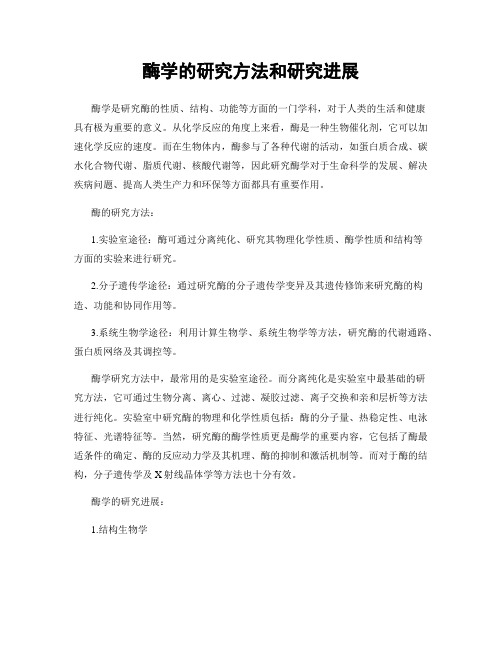
酶学的研究方法和研究进展酶学是研究酶的性质、结构、功能等方面的一门学科,对于人类的生活和健康具有极为重要的意义。
从化学反应的角度上来看,酶是一种生物催化剂,它可以加速化学反应的速度。
而在生物体内,酶参与了各种代谢的活动,如蛋白质合成、碳水化合物代谢、脂质代谢、核酸代谢等,因此研究酶学对于生命科学的发展、解决疾病问题、提高人类生产力和环保等方面都具有重要作用。
酶的研究方法:1.实验室途径:酶可通过分离纯化、研究其物理化学性质、酶学性质和结构等方面的实验来进行研究。
2.分子遗传学途径:通过研究酶的分子遗传学变异及其遗传修饰来研究酶的构造、功能和协同作用等。
3.系统生物学途径:利用计算生物学、系统生物学等方法,研究酶的代谢通路、蛋白质网络及其调控等。
酶学研究方法中,最常用的是实验室途径。
而分离纯化是实验室中最基础的研究方法,它可通过生物分离、离心、过滤、凝胶过滤、离子交换和亲和层析等方法进行纯化。
实验室中研究酶的物理和化学性质包括:酶的分子量、热稳定性、电泳特征、光谱特征等。
当然,研究酶的酶学性质更是酶学的重要内容,它包括了酶最适条件的确定、酶的反应动力学及其机理、酶的抑制和激活机制等。
而对于酶的结构,分子遗传学及X射线晶体学等方法也十分有效。
酶学的研究进展:1.结构生物学酶的结构生物学研究是酶学发展的一个重要方向,在新的微笑技术和新的结晶方法的加入下,解析酶分子晶体的速度越来越快。
同时,新的分子生物技术方法也为酶结构的研究提供了新突破口。
2.计算酶学计算酶学是把计算科学与酶学研究相结合的一门学科。
随着计算机运算能力的提高,计算酶学成为酶学研究的新的方法和工具。
在酶的分子模拟、酶结构的预测、生物信息学和系统生物学的研究中都有着广泛的应用。
3.酶催化机理研究酶催化机理研究是酶学研究的重要方向之一。
通过酶的特殊构象和活性位点的解析,分析和建立酶催化的反应机理,可以为酶催化机理的解析提供解决问题的方法。
同时,酶催化机理的研究也可以为酶的分子设计、酶抑制剂和活化剂的研究提供思路和方法。
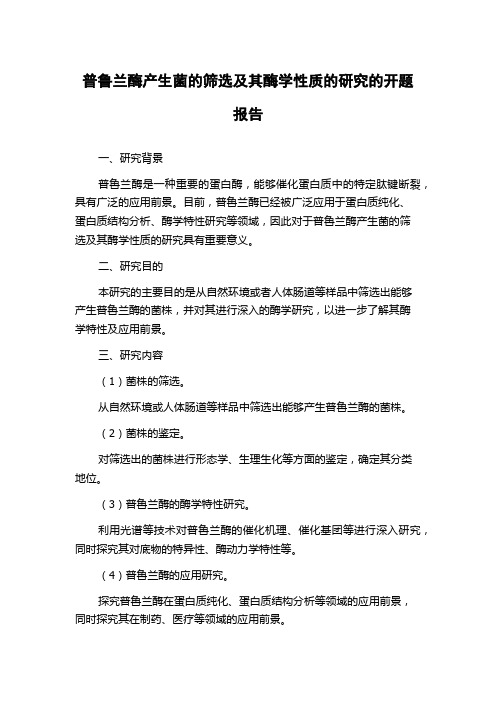
普鲁兰酶产生菌的筛选及其酶学性质的研究的开题报告一、研究背景普鲁兰酶是一种重要的蛋白酶,能够催化蛋白质中的特定肽键断裂,具有广泛的应用前景。
目前,普鲁兰酶已经被广泛应用于蛋白质纯化、蛋白质结构分析、酶学特性研究等领域,因此对于普鲁兰酶产生菌的筛选及其酶学性质的研究具有重要意义。
二、研究目的本研究的主要目的是从自然环境或者人体肠道等样品中筛选出能够产生普鲁兰酶的菌株,并对其进行深入的酶学研究,以进一步了解其酶学特性及应用前景。
三、研究内容(1)菌株的筛选。
从自然环境或人体肠道等样品中筛选出能够产生普鲁兰酶的菌株。
(2)菌株的鉴定。
对筛选出的菌株进行形态学、生理生化等方面的鉴定,确定其分类地位。
(3)普鲁兰酶的酶学特性研究。
利用光谱等技术对普鲁兰酶的催化机理、催化基团等进行深入研究,同时探究其对底物的特异性、酶动力学特性等。
(4)普鲁兰酶的应用研究。
探究普鲁兰酶在蛋白质纯化、蛋白质结构分析等领域的应用前景,同时探究其在制药、医疗等领域的应用前景。
四、研究意义(1)为普鲁兰酶的研究提供新的菌株资源,为生物工程、制药、医疗等领域的应用提供更多选择;(2)深入研究普鲁兰酶的结构和功能,揭示其催化机理及其对底物的特异性等酶学特性,有助于更好地探究普鲁兰酶的应用前景。
五、研究方案(1)样品的采集和处理。
从自然环境或人体肠道等样品中收集潜在的普鲁兰酶产生菌株,采用涂布法等方法进行分离和纯化。
(2)菌株的鉴定。
利用形态学、生理生化等方面的方法对菌株进行鉴定,确定其分类地位。
(3)普鲁兰酶的生产。
培养筛选出来的菌株,并对其发酵条件进行优化,最终得到高产普鲁兰酶的菌株。
(4)普鲁兰酶的纯化和酶学特性研究。
对普鲁兰酶进行常规分离纯化,利用光谱等技术研究其结构和功能,探究其催化机理和酶学特性。
(5)普鲁兰酶的应用研究。
探究普鲁兰酶在制药、医疗等领域的应用前景,为其进一步的应用研究提供理论支持。
六、预期成果(1)从自然环境或人体肠道等样品中筛选出普鲁兰酶产生菌株;(2)深入研究普鲁兰酶的酶学特性,详细揭示其结构和功能;(3)探究普鲁兰酶在制药、医疗等领域的应用前景,并为其应用提供更多选择。

微生物酶的分离纯化与酶学性质研究微生物酶在生物工程和生物技术领域具有广泛的应用,如食品工业、医药工业和环境工程等。
为了更好地利用微生物酶的功能,研究人员常常需要对微生物中的酶进行分离纯化和酶学性质的研究。
本文将介绍微生物酶的分离纯化方法和酶学性质的研究内容。
一、微生物酶的分离纯化方法微生物酶的分离纯化是指将微生物中的酶从其他组分中分离出来,并获得高纯度的酶样品的过程。
一般而言,微生物酶的分离纯化可以分为以下几个步骤:1. 细胞破碎:首先需要将微生物细胞破碎释放酶。
常见的破碎方法有超声波破碎、高压破碎和球磨破碎等。
2. 细胞层析:通过柱层析技术,可以将酶从细胞裂解液中进一步分离纯化。
常用的柱层析方法有凝胶层析、离子交换层析和亲和层析等。
3. 酶活测定:利用酶活测定方法可以确定酶的纯度和活力。
常用的酶活测定方法有酶促反应法、比色法和荧光法等。
二、微生物酶的酶学性质研究微生物酶的酶学性质研究是指对酶的催化活性、底物特异性、酶动力学参数和酶稳定性等进行研究。
这些研究可以为酶的应用提供理论依据。
1. 催化活性:通过测定酶在不同底物浓度和温度条件下的催化活性,可以确定酶的最适pH值和最适温度等。
2. 底物特异性:通过测试酶对不同底物的催化活性,可以确定酶对底物的特异性。
常用的方法有比色法、荧光法和质谱法等。
3. 酶动力学参数:通过测定酶在不同底物浓度下的催化速率,可以确定酶的酶动力学参数,如酶的最大催化速率和米氏常数等。
4. 酶稳定性:通过测定酶在不同pH值、温度和离子浓度等条件下的稳定性,可以确定酶的稳定性。
常用的方法有热失活曲线法、酶活测定法和聚丙烯酰胺凝胶电泳等。
结论微生物酶的分离纯化和酶学性质研究对于更好地利用酶的功能具有重要的意义。
通过适当的分离纯化方法可以获得高纯度的酶样品,而通过酶学性质的研究可以了解酶催化活性和特性,为酶的应用提供理论依据。
深入研究微生物酶的分离纯化和酶学性质,将有助于推动生物工程和生物技术的发展。
Breeding of D (–)-Lactic Acid High Producing Strain by Low-energy Ion Implantation and Preliminary Analysis of Related MetabolismTing-Ting Xu &Zhong-Zhong Bai &Li-Juan Wang &Bing-Fang HeReceived:21January 2008/Accepted:5May 2008/Published online:24June 2008#Humana Press 2008Abstract The low-energy nitrogen ion beam implantation technique was used in the breeding of mutant D (–)-lactic-acid-producing strains.The wild strain Sporolactobacillus sp.DX12was mutated by an N +ion beam with energy of 10keV and doses ranging from 0.4×1015to 6.60×1015ions/cm bined with an efficient screening method,an efficient mutant Y2-8was selected after two times N +ion beam implantation.By using the mutant Y2-8,121.6g/l of D -lactic acid was produced with the molar yields of 162.1%to the glucose.The yield of D -lactic acid by strain Y2-8was 198.8%higher than the wild strain.Determination of anaerobic metabolism by Biolog MT2was used to analyze the activities of the concerned enzymes in the lactic acid metabolic pathway.The results showed that the activities of the key enzymes responded on the substrates such as 6-phosphofructokinase,pyruvate kinase,and D -lactate dehydrogenase were considerably higher in the mutants than the wild strain.These might be affected by ion beam implantation.Keywords Nitrogen ion beam implantation .D (–)-Lactic-acid-producing strain .Mutation .Breeding .Metabolic influenceIntroductionFor centuries,lactic acid has traditionally been used in the food,textile,chemical,and pharmaceutical industries.In recent years,poly-L -lactic acid (PLLA)has attracted much interest as a renewable alternative to conventional petroleum-based plastics.Its properties make it useful for many applications such as biodegradable packaging and agricultural mulch film [1].However,thermal stability of PLA is not sufficiently high to someAppl Biochem Biotechnol (2010)160:314–321DOI 10.1007/s12010-008-8274-4T.-T.Xu :Z.-Z.Bai :L.-J.Wang :B.-F.He (*)College of Life Science and Pharmaceutical Engineering,Nanjing University of Technology,Xinmofan Road 5,Nanjing,210009Jiangsu,China e-mail:bingfanghe@applications.A polymer blend of PLLA and poly-D-lactic acid(PDLA)gives a racemic crystal called a stereo-complex;this blended PLLA/PDLA polymer has a melting temperature(T m)of225°C,50°C higher than that of pure PLLA(177°C)due to the unusually strong interaction between PLLA and PDLA chains[2,3].The production of D-lactic acid through fermentation has been reported in several articles[4–6],but their yields were quite low compared with L-lactic acid.Therefore,the efficient production of D-lactic acid would be a breakthrough,allowing the large-scale application of poly lactic acid with a high melting point.Low-energy ion implantation,a new mutagenesis technique,was used in the breeding of rice seeds for the first time by Yu et al.[7].From then on,this method has been widely applied in the breeding of crops,plants,and microbes[8–10].When low-energy ions are implanted into organic cells,some important biomolecules such as amino acids and nucleotides are decomposed,and DNA can be destroyed[11].This means that ion beam mutation has a wide range of biological effects.Experimental results showed that low-energy ion implantation has many advantages,such as a low injury rate,higher mutation rate,and wider spectrum of mutation than traditional mutation methods[12].The mechanism of low-energy ion implantation acting on microbes has not yet been clarified.In this work,we screened an efficient mutant for D-lactic acid production through ion beam implantation and conducted a pilot study on the influence of N+ion implantation on the metabolism concerned with the lactic acid fermentation pathway of the cells. Materials and MethodsMicroorganism and MediaSporolactobacillus sp.DX12was isolated from soil and stored in our lab[13].The agar medium contained(per liter):glucose20g,yeast extract2g,peptone2g,KH2PO41g,corn steep liquor2ml,sodium acetate2g,MgSO40.2g,MnSO410mg,and FeSO410mg.The selection agar plates had the same compositions except that100g/l(150g/l for second screen)of glucose and0.1g/l bromocresol green(pH3.6yellow−pH5.2blue)were added [14].The seed culture medium was composed of(g/l):glucose20,yeast extract2,peptone 2,corn steep liquor5ml,MgSO40.2,MnSO40.01,FeSO40.01,and CaCO320,and the fermentation medium was composed of(g/l):glucose100,(150g/l for second screen),yeast extract3,corn steep liquor20ml,MgSO40.5,MnSO40.01,FeSO40.01,and CaCO3100.Ion Implantation EquipmentThe implantation sources were produced by an ion beam implanting instrument LZD-900 designed by Chinese Southwestern Institute of Physics.Procedure of Ion Implantation on the Cells of Sporolactobacillus sp.DX12Active cells were harvested from the culture after48h anaerobic incubation at37°C in agar medium.The fresh cultured cells of DX12were diluted in sterilized physiological salt solution,and80μl suspension was spread on an empty sterilized Petri dish(75mm)and desiccated by filtrated air to make a dry membrane of cells.Then,the dishes were put into the sample holder and implanted by nitrogen ion beam with energy of10keV.The dose for implantation ranged from0.40×1015to6.60×1015ions/cm2.Selection of Efficient D-Lactic-Acid-Producing MutantsAfter ion implantation,the DX12cells were washed out from the plates with sterilized physiological salt solution.The suspension was spread over three to five selection agar plates to isolate high-yield D-lactic-acid-producing mutants.The colonies showing large halos(yellow)on the agar medium were selected.For the flask test,the mutants selected after48h culture on selection agar plates(without bromocresol)were inoculated to a150-ml flask containing60ml seed culture medium and were shaken anaerobically at170rpm at 37°C with liquid sealing by liquid paraffin for24h.A250-ml flask containing120ml of the fermentation medium was inoculated with10%of the above inoculums and cultured in a rotary shaker at150rpm at37°C for7days.Analysis of Concentration and Optical Purity of Produced Lactic AcidAfter the cells and CaCO3had been removed by centrifugation,fermentation fluid was put through cation exchange resin to change calcium lactate into lactic acid eluted with distilled water for further detection.The concentration of lactic acid in the fermentation supernatant was measured by high-performance liquid chromatography(HPLC)using a C18column (Allteck)under the following conditions:mobile phase,2.5mM NH4H2PO4;flow rate, 0.5ml/min;temperature,30.0°C.The detection wavelength was UV230mm.The optical purity of the produced lactic acid was measured by HPLC with a UV detector(254nm) under the following conditions:ligand exchange column,Sumichiral CA5000(150×4.6mm,Sumika Chemical Analysis Service,Osaka,Japan);mobile phase,1mM CuSO4; flow rate,1.0ml/min and temperature,35.0°C.Cell GrowthGrowth was determined by measurement of optical density(OD)at660nm.As it is difficult to measure growth by OD in the presence of calcium carbonate,the sample of broth was settled down for a steady few minutes.The most of calcium carbonate precipitated with few cells because the sediment speed of calcium carbonate is faster than the cells’.Then,the upper layer of the sample broth was diluted to measure the optical densities at660nm as the rough cell growth.It was confirmed that the OD660nm of cell growth showed an approximate direct proportional relation to the protein concentration of the broth.Metabolic Activity Assay Using Biolog Microstation SystemBiolog Inc.(Biolog,Inc.,Hayward,CA,USA)provides a rapid convenient technique to conduct simultaneous testing of different bacterial phenotypes using cell metabolism as the reporter system[15,16].The commercially available Biolog microplates contain a certain amount of tetrazolium violet,different substrates,and the necessary buffer.Tetrazolium violet is used as a redox dye to colorimetrically detect(at590nm)the metabolic activity of cells for the substrates.The more metabolic activity the cells have,the more purple color will accumulate due to a reduction of the dye[17,18].In this research,the Biolog MT2MicroPlate[19] containing a tetrazolium redox dye and a necessary buffer without substrates was used to analyze the metabolic activities of the mutant and wild strain.The substrates related to the metabolic pathway of lactic acid such as glucose,fructose-6-phosphate,glycerophosphate disodium,and sodium pyruvate were selected and added to the different wells of MT2plate to assay the relevant metabolic activity of the D-lactic acid fermentation pathway.Following the established Biolog procedures [15],suspensions of the wild strain and mutant were adjusted to give 60%transmittance with the Biolog turbidimeter.Subsequent-ly,15μl of different substrates and 135μl of the cell suspension were added into the MT2MicroPlates.The microplates were incubated in an anaerobic culture box (Bug box dual gas,Ruskinn,UK)at 37°C,and the reduction of tetrazolium violet was determined at 6-h intervals.Results and DiscussionSurvival Rate Curve and Choice of Mutant DoseThe ion source can be varied depending in the specific purpose,and different ion species such as N +,C 2+,and Ti 2+can be produced.In this study,N +was chosen as the ion source,and the energy was fixed at 10keV .Figure 1shows the effect of the dose of nitrogen ion beam irradiation to DX12cells on the survival rate.The survival rate was related to the dose of N +implantation and showed a characteristic curve shaped like a saddle.The survival rate decreased as the dose was increased (0.6×1015to 2.6×1015ions/cm 2),but when the dose was increased within a short range (3.2×1015to 4.8×1015ions/cm 2),the survival rate showed a temporary increase and then decreased as the dose continued to increase.The falling,rising,and then falling survival pattern was called “saddle curve ”[20].The mechanisms of low-energy ion irradiation are not totally understood.Low dosage ions only incur damage and etching of the cell surface;thus,the survival rate is higher.With the increase in dosage,the superficial injury to the cell becomes serious,and massive free OH radicals and radials cause the survival rate to drop.When they drop to a certain extent (3.2×1015–4.8×1015ions/cm 2),some kind of internal repair mechanism of the cell such as SOS (error-prone repair)is activated,and the survival rate have a temporary rise.But when the dose is further increased,the cell damage becomes irreparable.According to some reports,the “saddle ”region of the survival curve,in which the survival rate ranges from 10%to 30%,is the region prone to mutate [9,20],and doses ranging from 2.4×1015to 5.2×1015ions/cm 2were decided as the appropriate dose for further mutation.1246720406080100S u r v i v a l r a t e (%)Dose of nitrogen ions (×1015ions/cm 2)53Fig.1The survival rate curve of nitrogen ion beam irradiated Sporolactobacillus sp.DX12cells.The survival rate can be calculated using the number of clones scored in control plates without ion implantation as 100%.The averages fortwo independent experiments are presentedScreening Using Agar Plates Containing High Concentrations of Glucose and Bromocresol GreenCombining the selection on selection agar plates,the mutants were isolated after DX12cells had been implanted by N +ions (2.49×1015to 4.82×1015ions/cm 2).Twenty colonies showing comparatively large yellow halos were selected out.They were inoculated and fermented in flasks as described above.It was found that the D -lactic acid yields of all mutants were higher than that of the wild strain.Table 1shows the growth and lactic acid yield of eight mutants,which produced more than 80g/l of D -lactic acid (D -LA)from 100g/l glucose.The yields were almost two times greater than the wild strain,which could only produce 40.7g/l D -lactic acid from 60g/l glucose (the wild strain could not resist more than 60g/l glucose [13]).Mutant Y1-14produced 89g/l D -lactic acid and was used in a second mutation also by N +ion implantation.Mutant Y1-14was further mutated by N +ion beam implantation with the dose of 3.80×1015–5.40×1015ions/cm 2according to the survival rate curve.The glucose concentration of the selection agar plates and fermentation medium were increased to 150g/l to screen more efficient mutants.Ten colonies were selected out and detected through flask batch fermentation.These mutants showed higher producibility than strain Y1-14(Table 2),and the mutant Y2-8was confirmed to produce 143.6g/l D -lactic acid.This was equivalent to a 191.5%molar yield to the glucose.Mutant Y2-8was generated and inoculated to flask fermentations to test their stability in producing lactic acid (Table 3).It can be seen from the results that the D -lactic acid producibility of the high-yield mutant fell during the initial generation and then remained relatively stable in subsequent generations.Average yield of D -lactic acid during two to four generations was 121.6g/l.Detection of Enantiomeric Purity of Produced Lactic AcidThe enantiomeric purity of the product by mutant Y2-8was 99.08%of D -type,higher than the parent strain (96%).This means that a better quality of product was obtained using Sporolactobacillus sp.mutant Y2-8.In recent studies,a high productivity (120g/l)of D -lactic acid was obtained by genetically engineered Corynebacterium glutamicum ,but it was fermented using nutrient-Table 2The D -lactic acid yield and growth of mutants after second N +implantation.StrainY2-1Y2-3Y2-4Y2-5Y2-6Y2-7Y2-8Y2-9Growth (OD 660)7.779.719.41 6.118.31 6.2011.247.84D -LA (g/l)115.2120.6124.296.3111.7106.2143.6100.3The averages for three independent experiments are presented.Table 1The D -lactic acid yield and growth of mutants after first N +implantation.StrainWild Y1-2Y1-3Y1-7Y1-9Y1-13Y1-14Y1-16Y1-18Growth (OD 660) 4.83 4.77 4.09 5.27 5.19 5.87 5.30 5.36 5.90D -LA (g/l)40.7a86.881.888.480.488.289.287.387.3The averages for three independent experiments are presented.aThe wild strain could not resist more than 60g/l glucose.rich medium with the supplement of biotin,thiamine,and some antibiotics [21].Lactobacillus delbrueckii produced D -lactic acid from sugarcane juice or sugar beet juice,but the optical purity is relatively low [22].In this work,high productivity (121.6g/l)of D -lactic acid was obtained by mutant Y2-8with related longer fermentation times.Future study will focus on breeding more efficient mutants through further ion beam implantation to short fermentation period.Analysis of Metabolic Activity Related with D -Lactic Acid Fermentation for Mutant and Wild StrainTypical homolactic metabolic pathway including glucose becomes pyruvate through the glycolytic flux and pyruvate toward D -lactic acid production through D -lactate dehydroge-nase (LDHD)under anaerobic conditions (see Fig.2).Within the pathway,glucokinase (GK),6-phosphofructokinase (6-PFK),pyruvate kinase (PYK),and LDHD are the key enzymes [23].In this research,the Biolog approach was used to analyze the metabolic activities of the concerned substrates in mutant Y2-8and the wild strain.As Fig.3shows,the amounts of reduced tetrazolium increased rapidly in the metabolic analysis of mutant Y2-8using four kinds of substrates related with the key enzymes ofglucokinaseglucosephosphate isomeraseDihydroxy-acetone-Ppyruvate kinaseLactatePi++NADH+H NAD Fig.2The homolactic metabolic pathway of lactic acid fermenta-tion.Within the pathway,glucokinase (GK ),6-phosphofructokinase (6-PFK ),pyruvate kinase (PYK ),andD -lactate dehydrogenase (LDHD )are the key enzymesTable 3Stability of mutant Y2-8during generation.Regeneration times 1234Growth (OD 660)11.249.028.889.67D -LA (g/l)143.6121.3119.8123.6lactate fermentation,while the amounts of reduced tetrazolium stayed at low levelsaccording to the metabolic analysis of the wild strain.The metabolic activity of mutant Y2-8using glycerophosphate and pyruvate as substrate were 50%higher than the wild strain.These results suggest that the activities of the related enzymes,especially lactate dehydrogenase,in mutant Y2-8was obviously higher than in the wild strain DX12.Glucokinase responding on glucose was a key enzyme that turns glucose into an Embden –Meyerhof –Parnas pathway.Another key enzyme responding on fructose-6-phosphate was 6-phosphofructokinase.The activity levels of mutant Y2-8metabolizing D -glucose and fructose-6-phosphate were 40%and 100%higher than that of the wild strain.All of the metabolic speeds of the tested substrates concerned with the key enzyme of lactic acid formation were significantly faster in the mutant than in the wild strain.These results suggested that the enzymes concerned with the lactic acid fermentation pathway were activated through the mutation by N +ion beam implantation.There are only a few of research on mechanisms of mutation by ion beam implantation.One important biological effect is the mutation of DNA.DNA mutation can affect the activities of enzymes and cause the increase or decrease of some metabolites.The decomposition of amino acids and nucleotides induced the change of DNA structure or even the break of DNA strand [24,25].The effects of ion beam implantation on metabolic ability related to the main key enzymes of D -lactic acid fermentation were elucidated in this0.10.20.30.40.50.60.70.80.91.0Incubation Time(h)A b s o r b a n c e V a l u e (O D 590)0.10.20.30.40.50.60.70.80.91.0 Incubation Time(h)A b s o r b a n c e V a l u e (O D 590)abFig.3The metabolic activities of mutant Y2-8(a )and the wild strain (b )on the substrates related to the key enzymes of lactate fermentation.The MT2microplate with the addition of the substrates was incubated anaerobically.The averages for two independent experiments are presented.The reduction oftetrazolium violet is expressed by the change of the absorbance value at 590nm.D -Glucose(filled square ),6-p-fructose (filled circle ),glycerophosphate (filled triangle ),pyruvate (filled inverted triangle )study;continuing studies will yield further insight into the differences of transcription regulation in the key enzyme of lactic acid formation between the mutants with the wild strain.Acknowledgments We thank Dr.Long Yu of the Nanjing University of Technology for technical support. This work was supported by the973program(grant no.2003CB716004)and the863program(grant no. 2006AA020102)of China.References1.Wee,Y.J.,Kim,J.N.,&Ryu,H.W.(2006).Food Technology and Biotechnology,44,163–172.2.Ikada,Y.,Jamshidi,K.,Tsuji,H.,&Hyon,S.H.(1987).Macromolecules,20,904–906.3.Tsuji,H.,&Fukui,I.(2003).Polymer,44,2891–2896.4.Bustos,G.,Moldes,A.B.,Alonso,J.L.,&Vázquez,M.(2004).Food Microbiology,21,143–148.5.Tanaka,T.,Masahiro,H.,Suguru,T.,Kenji,S.,Sadami,O.,&Masayuki,T.(2006).BioresourceTechnology,97,211–217.6.Ishida,N.,Suzuki,T.,Tokuhiro,K.,Nagamori,E.,Onishi,T.,Saitoh,S.,et al.(2006).Journal ofBioscience and Bioengineering,101,172–177.7.Yu,Z.L.,Deng,J.G.,He,J.J.,Huo,Y.P.,Wu,Y.J.,Wang,X.D.,et al.(1991).Nuclear Instruments&Methods in Physics Research,Section B,59–60,705–708.8.Yu,Z.L.,Yang,J.B.,Wu,Y.J.,Cheng,B.J.,He,J.J.,&Huo,Y.P.(1993).Nuclear Instruments&Methods in Physics Research,Section B,80–81,1328–1331.9.Chen,Y.,Lin,Z.X.,Zou,Z.Y.,Zhang,F.,Liu,D.,Liu,X.H.,et al.(1998).Nuclear Instruments&Methods in Physics Research,Section B,140,341–348.10.Gu,S.B.,Yao,J.M.,Yuan,Q.P.,Xue,P.J.,Zheng,Z.M.,Wang,L.,et al.(2006).AppliedMicrobiology and Biotechnology,72,456–461.11.Huang,W.D.,Yu,Z.L.,&Zhang,Y.H.(1998).Chemical Physics,237,223–231.12.Feng,H.Y.,Yu,Z.L.,&Chu,P.K.(2006).Materials Science&Engineering.R,54,49–120.13.Ding,Z.J.,Bai,Z.Z.,Sun,Z.H.,Ouyang,P.K.,&He,B.F.(2004).Chinese Journal of BioprocessEngineering,2,30–36(in Chinese).14.Shigenobu,M.,Lies,D.,Tomohiro,A.,Minako,H.,Liu,T.J.,&Mitsuyasu,O.(2004).Journal ofBioscience and Bioengineering,97,19–23.15.Guckert,J.B.,Carr,G.J.,Johnson,T.D.,Hamm,B.G.,Davidson,D.H.,&Kumagai,Y.(1996).Journal of Microbiological Methods,27,183–197.16.Covert,M.W.,Knight,E.M.,Reed,J.L.,Herrgard,M.J.,&Palsson,B.O.(2004).Nature,429,92–96.17.Hobbie,E.A.,Watrud,L.S.,Maggard,S.M.,Shiroyama,T.,&Rygiewicz,P.T.(2003).Soil Biology&Biochemistry,35,303–311.18.Koo,B.M.,Yoon,M.J.,Lee,C.R.,Nam,T.W.,Choe,Y.J.,Jaffe,H.,et al.(2004).The Journal ofBiological Chemistry,279,31613–31621.19.Dos Santos,L.F.,Defrenne,L.,&Krebs-Brown,A.(2002).Analytica Chimica Acta,456,41–45.20.Su,C.X.,Zhou,W.,Fan,Y.H.,Li,W.,Zhao,S.G.,&Yu,Z.L.(2006).Journal of IndustrialMicrobiology&Biotechnology,33,1037–1042.21.Okino,S.,Suda,M.,Fujikura,K.,Inui,M.,&Yukawa,H.(2008).Applied Microbiology andBiotechnology,78,449–454.22.Calabia,B.P.,&Tokiwa,Y.(2007).Biotechnology Letters,29,1329–1332.23.De V os,W.M.,&Hugenholtz,J.(2004).Trends in Biotechnology,22,72–79.24.Wang,Q.,Zhang,G.,Du,Y.H.,Zhao,Y.,&Qiu,G.Y.(2003).Mutation Research,528,55–60.25.Gu,S.B.,Li,S.C.,Feng,H.Y.,Wu,Y.,&Yu,Z.L.(2008).Applied Microbiology and Biotechnology,78,201–209.。